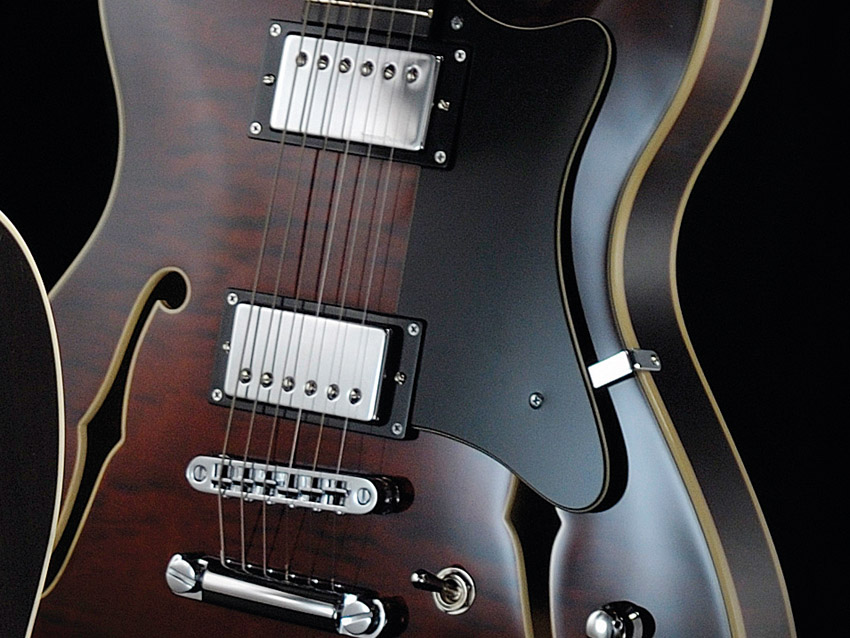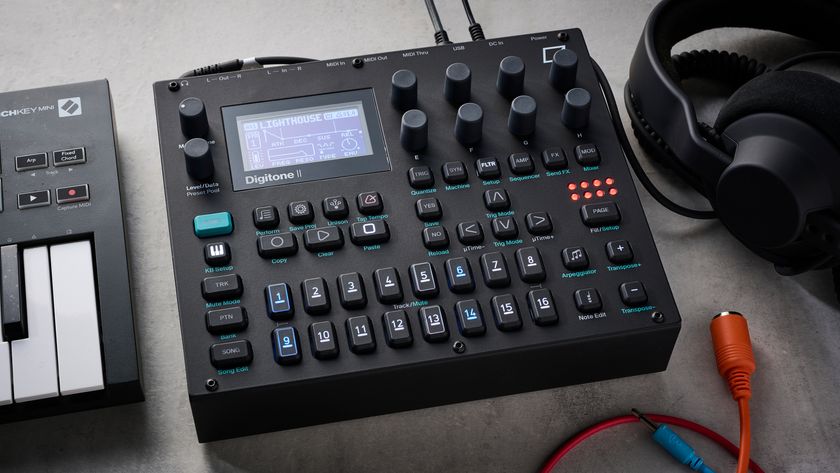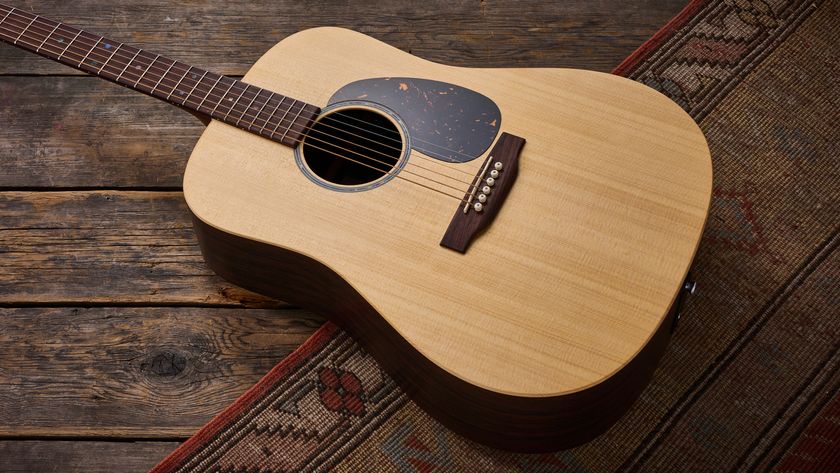MusicRadar Verdict
A classy, if not hugely original, take on Gibson's ES-335.
Pros
- +
Build quality. Weight. Resonance and playability. Characterful old-school tones.
Cons
- -
We'd just like a bigger neck!
MusicRadar's got your back

Framus Mayfield Custom Flamed Maple

Framus Mayfield Custom Flamed Maple

Framus Mayfield Custom Flamed Maple
By its own admission Warwick took a while to get Framus right. Over a decade into the brand's relaunch, however, the quality and design has gone from strength to strength and the new Mayfields really are up there with the big boys.
The inspiration is obvious, but proper laminated-body thinlines in the style of Gibson's ES-335 aren't too common. This paucity of competition is one reason why the ES-335 remains such an electric guitar icon.
The Framus Mayfield, however, uses pressed laminate top and back, albeit with solid sides, and a maple centre-block. Pretty much the real deal.
"There's soup from the neck pickup, ring, attack and brightness from the bridge, and a funky mix sits between."
Shape-wise, it's very different, with thinner horns, less bulbous lower bouts and slightly more compact too: 389mm (15.3-inches) across the lower bout and 473mm long (18.6-inches), as opposed to the ES-335's 406mm (16-inches) by 483mm (19-inches). Thickness-wise, however, it's similar with a rim depth of 46mm and a maximum depth of around 65mm.
Weight is good too, more vintage-like than many contemporary, heavier Gibson ES-335s.
The Custom tops the line in the Mayfield mini range and comes with a choice of four body materials. Our flamed maple version, in its high polish antique tobacco stain finish, is quite a looker but in an understated manner.
The laminate top and back feature very smartly centre-jointed and nicely figured facings, while both the solid sides (thin with un-kerfed linings) and neck have vibrant flamed figuring.
Compared to a solidbody, a thinline like this is a complex build. Aside from the centre-blocked hollow body, both top and back edges are bound but Framus does it all perfectly: the cream plastic binding with inner black/white/black purfling is remarkably clean, the top edges nicely rounded.
This almost obsessive detailing continues to the neck with its impressive fretwork (Framus uses the Plek set-up system, as Gibson does) only marred by some visible filler/adhesive around the inlays although it's far from sloppy.
The 'board isn't bound but the fret slot ends are filled and the edges nicely rounded. The Mayfield's neck is less Gibson like than its build suggests. With a slightly narrow width, the shape is quite a thin-depth 'C' (19mm at the first fret, 22mm at the 12th, slightly thinner than the Framus specs).
It's not ultra skinny, of course, but lacks the bulk of many classic Gibsons. It is, however, very comfortable and perfectly set-up. Playability is superb.
Build-wise there's very little not to like. Okay, the black-faced headstock looks a little dumpy, but the inlays are smart, as is the embossed metal truss-rod cover. It's certainly not a deal breaker on the style front.
More importantly the string splay and back angle are less extreme than a Gibson, which will help with tuning stability, though we wouldn't expect that to be an issue here anyway as the nut work is excellent and we get locking tuners, albeit with rather high slot-head locks.
Quality continues with Tone Pros tune-o-matic bridge and stud tailpiece, a pair of chrome-covered Seymour Duncan humbuckers, small chromed metal knobs with rubber grips and a chrome-topped pickup selector placed a little closer to the bridge than on an ES-335. There's even a well-chromed metal jack plate firmly screwed to the body sides - another change from the classic recipe.
Sounds
The Custom feels really good from the off. Okay, if you're used to a bigger neck it'll take a little while to get used to this, and they ship with 0.009s - we'd prefer 0.010s as standard and probably go up to 0.011s. It feels like the 0.009s don't quite drive the guitar enough to really maximise the lightweight resonant construction.
But there's no doubt the sounds are in the right ballpark. There's soup from the neck pickup, ring, attack and brightness from the bridge and the wonderful slightly funkier and hollowed mix sits between those two extremes. And by using the volume and tones you can conjure a seemingly endless selection of subtle colours.
All the volume and tone tapers work well, and it proves a very responsive guitar that, like its inspiration, is hard to pigeonhole. If anything the Custom, with its more classic PAF-intended pickups, has a more classic tonality, from clean biting blues from the bridge pickup to the softer, jazzier neck pickup and that timeless mixed pickup tone.
But turn up the wick a bit and it eases into Clapton-esque Cream and more fusion-y styles with plenty of snap and air. Keep on cranking and it'll easily edge into musical feedback while the guitar vibrates on your body.
It's certainly not the biggest and boldest ES-335 style guitar we've every played; it does sound a little polite, perhaps, and a little more sophisticated than some.
These new Mayfields prove that Warwick - who owns Framus - can make guitars every bit as well as it makes basses. The Custom is a genuine class act, the only thing that we'd like to see would be a bigger neck, but everyone's different and the slimmer neck here might well be your personal ideal.
Price-wise The Custom seems fair bearing in mind the limited competition and no doubt street prices will be trimmer still. The big 'if' of course is that many, many players want an ES-335 with Gibson on the headstock, and why not?
Framus, therefore, has a lot to compete with on that level but in terms of build quality, playability and sound it has little to worry about. Add in an extensive custom order list of options and if you're looking for a thinline with class, elegance and tons of variety in terms of specification, this is a very good place to start.
Dave Burrluck is one of the world’s most experienced guitar journalists, who started writing back in the '80s for International Musician and Recording World, co-founded The Guitar Magazine and has been the Gear Reviews Editor of Guitarist magazine for the past two decades. Along the way, Dave has been the sole author of The PRS Guitar Book and The Player's Guide to Guitar Maintenance as well as contributing to numerous other books on the electric guitar. Dave is an active gigging and recording musician and still finds time to make, repair and mod guitars, not least for Guitarist’s The Mod Squad.

Heart’s Nancy Wilson told Chappell Roan that she’ll be her "rock and roll auntie if you ever need any advice,” and she also co-wrote and recorded her favourite song
![Justin Hawkins [left] of the Darkness plays an open G on his offset electric and closes his eyes as he performs onstage; soul-reggae icon Johnny Nash [right] frets a chord on his acoustic and wears a patched denim jacket.](https://cdn.mos.cms.futurecdn.net/hWzCjD9ZWQiPPjMtTWiFfa-840-80.jpg)
“It was probably the first time I’d ever sort of listened to one and gone, ‘What is that? I want to learn how to do that!’”: How a soul and reggae legend introduced the Darkness' Justin Hawkins to diminished chords

"This risked giving consumers the misleading impression that platinum tickets were better”: Ticketmaster criticised over Oasis reunion tickets debacle, but this time it's got nothing to do with dynamic pricing










